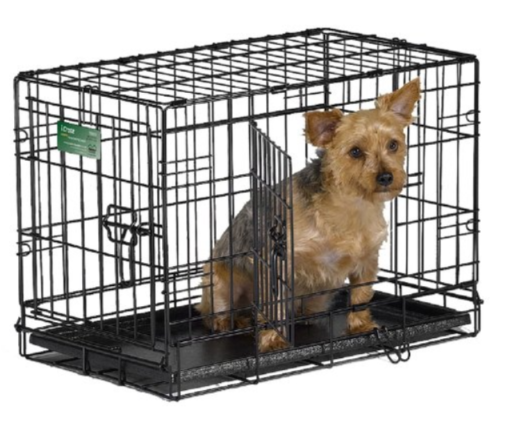Crate Training for a Puppy
Crate Training for a Puppy: Its Benefits
 Crate training for a puppy comes with a definite set of advantages. Mainly, it’s an easy way to save your home from nasty cleanup and odors when housetraining your puppy.
Crate training for a puppy comes with a definite set of advantages. Mainly, it’s an easy way to save your home from nasty cleanup and odors when housetraining your puppy.
Honestly, does the smell ever really go away? You don’t have to worry about that when you crate train puppy.
Get FREE Video Dog Training >>
Secondly, a big benefit to crate training for a puppy is making your little guy feel safe. Some puppy owners are skeptical about crate training for puppies, but there is absolutely no reason to be. When I took my dachshund, Cosita, to obedience school because she was impossible to house train, the trainers taught me that dogs are den animals and actually feel secure in their own crate.
Of course now that I know what I do, I’d never house train another puppy any other way. There’s just no reason not to.
Other Benefits to Crate Training for Puppies
- · Prevents the development of bad chewing habits
- · Stress reduction visiting the vet or groomer because they’re used to being in a crate
- · Guarantees its safety, in case you are not present to provide round the clock care
- · Aids in providing temporary confinement when faced with medical or health issues
- · Provides a safe haven for the pup to go when it gets stressed, tired or scared
- · Prevents the development of separation anxiety
Types of Crates to Crate Train Puppy
As you begin crate training, there are two main crate styles to consider:
1. Small crate where the puppy can stand up, turn around, and lay down, but that’s about it. There’s no other room to spare. This type discourages your puppy from soiling the crate because puppies don’t like to mess in their bed.
This is the way my doxie, Cosita, was trained… with the small crate.
2. Crate within a pen (or attached to a pen) where the puppy gets to leave the crate and do his business in the pen.
Get Started Crate Training Puppies
Training your pup to love his crate might require a little bribery. Use treats to get him inside the crate, and once inside, ensure that he’s rewarded. Repeat that process a few times with breaks in between, until your puppy will go into his crate without the treats.
You can try and introduce your puppy to the crate without treats, but if he’s reluctant, go for the treats!
I like to associate a word to the crate so he knows when it’s time to go there. Simply use the word each time you place him inside. Once he starts to get the hang of it, you can point to the crate and say the word, and possibly gently guide him over.
Next up, you close the door. Don’t rush this step. Wait until your dog goes into the crate of his own free will. Otherwise he might become afraid of the crate. Be sure and put a toy or two inside.
Get FREE “Dog Training Videos”Crate Training Puppies: How to Go About House training
Basically when crate training puppies for house training purposes, you want to make sure they are in the crate, outside, or in your arms at all times. Remember this is only until they are house trained, but the reason for this is to virtually eliminate any “accidents.”
 You want to feed and water your puppy twice a day. Immediately upon your puppy completing her meal, you take her outside to go. Once she’s done her business you can keep her outside to play awhile, or return to her crate. Or like I mentioned, if she’s small like a dachshund, you can carry her around for awhile. But you don’t want to give her a chance to make a mistake.
You want to feed and water your puppy twice a day. Immediately upon your puppy completing her meal, you take her outside to go. Once she’s done her business you can keep her outside to play awhile, or return to her crate. Or like I mentioned, if she’s small like a dachshund, you can carry her around for awhile. But you don’t want to give her a chance to make a mistake.
Oh, and of course, take your pup outside right after she wakes up. After she’s done her business, you can bring her inside for breakfast, but right back out again after she eats.
Keep this up for awhile, and you’ll have your puppy house trained without ruining your home with puppy urine all over the place. If you are worried about urine smell, this Lavender & Primrose is a really good natural product.


